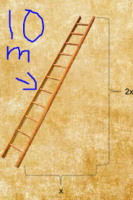Find x in right-angled triangle
- Thread starter witte1234
- Start date
Dr.Peterson
Elite Member
- Joined
- Nov 12, 2017
- Messages
- 16,762
The formula is the Pythagorean Theorem, [MATH]a^2 + b^2 = c^2[/MATH]. Put each of the three sides into that, and you'll have an equation you can solve for x.I need to find the x, and i wanna know how i should approach this kind of problem. Thanks for your time
Note: Please show the formula
Dr.Peterson
Elite Member
- Joined
- Nov 12, 2017
- Messages
- 16,762
I cant really see how that would work because both sides a and b are unkown. I Think i would use sin or cos in someway, thanks for your reply
Haven't you learned algebra? Replace a and b with expressions, and c with its value, and you'll have an equation you can SOLVE. Try it and see; don't give up without doing anything.
Trig will not help.
The exact question on my problem is: The ladder needs to be sat in a place so its high(2x) is two times how far it is pulled out(x)
I might be dumb, but can u show me the whole thing with an answer, because i can't figure this out. Thanks for your time
I might be dumb, but can u show me the whole thing with an answer, because i can't figure this out. Thanks for your time
Dr.Peterson
Elite Member
- Joined
- Nov 12, 2017
- Messages
- 16,762
Jomo gave you the equation!The exact question on my problem is: The ladder needs to be sat in a place so its high(2x) is two times how far it is pulled out(x)
I might be dumb, but can u show me the whole thing with an answer, because i can't figure this out. Thanks for your time
Now we need to see where you need help in solving it. Expand to remove parentheses, combine like terms, and solve. It isn't as hard as you appear to expect.
Well there is an ancient proof that says this problem cannot be solved exactly in the real world. So if this is a practical problem, you cannot get an exact decimal answer, and one (inefficient) way to solve your practical need is to experiment using a tape measure and chalk until you have the ladder arranged in a good enough way.
Of course, if this is a problem in a math class, what is wanted is is an exact answer, which can then be applied to practical problems without the need for experimentation.
[MATH]a^2 + b^2 = 10^2.[/MATH]
Hmm two unknowns requires two equations involving the unknowns. Do I know a relationship involving a and b????
Of course, if this is a problem in a math class, what is wanted is is an exact answer, which can then be applied to practical problems without the need for experimentation.
[MATH]a^2 + b^2 = 10^2.[/MATH]
Hmm two unknowns requires two equations involving the unknowns. Do I know a relationship involving a and b????
Based on the picture, it seems that [MATH]a = x[/MATH] and [MATH]b = 2x[/MATH], so that would make the equation [MATH]x^2 + (2x)^2 = 10^2[/MATH]. You're in luck: there is only one variable!I cant really see how that would work because both sides a and b are unkown.

